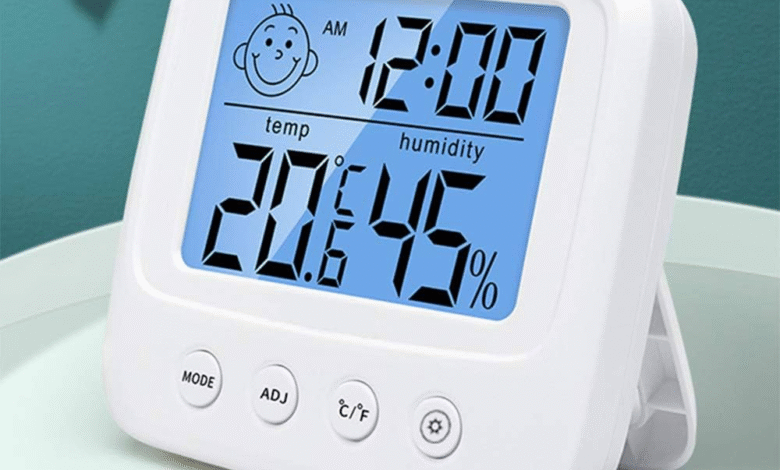Top Benefits of Using a Digital Air Thermometer at Home

Introduction to Digital Air Thermometers
In today’s modern world, maintaining optimal indoor air quality and temperature has become increasingly important for homeowners. Digital air thermometers have emerged as essential tools that go far beyond simple temperature measurement, offering comprehensive solutions for creating healthier, more comfortable, and energy-efficient living spaces. These sophisticated devices represent a significant advancement over traditional analog thermometers, providing homeowners with unprecedented control over their indoor environment.
The evolution from mercury-based and analog thermometers to digital alternatives has revolutionized how we monitor and manage indoor temperatures. Digital air thermometers utilize advanced sensor technology and microprocessors to deliver precise readings while offering additional features that enhance the overall user experience. As smart home technology continues to advance, these devices have become integral components of modern home automation systems.
Understanding the multitude of benefits that digital air thermometers provide can help homeowners make informed decisions about their indoor climate control systems. From energy savings to health improvements, these devices offer compelling advantages that justify their adoption in residential settings. The technology has matured to the point where digital thermometers are not only more accurate than their analog counterparts but also more affordable and accessible to the average homeowner.
Enhanced Accuracy and Precision
One of the most significant advantages of digital air thermometers is their superior accuracy compared to traditional analog models. Digital sensors can measure temperature changes as small as 0.1 degrees Fahrenheit, providing homeowners with precise information about their indoor environment. This level of accuracy is crucial for maintaining consistent comfort levels and optimizing HVAC system performance.
Traditional analog thermometers often suffer from calibration drift over time, leading to increasingly inaccurate readings. Digital thermometers, however, maintain their accuracy through sophisticated calibration algorithms and high-quality sensors that resist degradation. Many digital models also feature automatic calibration functions that ensure continued precision throughout their operational lifespan.
The precision offered by digital thermometers extends beyond simple temperature measurement. Many modern units also monitor humidity levels, air quality indices, and even atmospheric pressure. This comprehensive environmental monitoring capability allows homeowners to make more informed decisions about their indoor climate control strategies. The ability to track multiple environmental parameters simultaneously provides a holistic view of indoor air quality that was previously impossible with single-function analog devices.
Furthermore, digital thermometers eliminate the parallax error common with analog gauges, where the reading can appear different depending on the viewing angle. The clear digital display ensures that temperature readings are consistent and easily interpretable, regardless of the observer’s position or lighting conditions in the room.
Real-Time Temperature Monitoring
Digital air thermometers excel in providing continuous, real-time temperature monitoring that keeps homeowners informed about their indoor environment throughout the day. Unlike analog thermometers that require manual checking, digital models can display current temperatures continuously and often feature data logging capabilities that track temperature trends over time.
This continuous monitoring capability proves invaluable for identifying temperature fluctuations that might indicate HVAC system issues or areas of poor insulation. By tracking temperature patterns throughout different times of day and seasons, homeowners can identify opportunities for energy optimization and comfort improvement. The ability to monitor temperature trends also helps in predicting when HVAC maintenance might be needed.
Many digital thermometers feature programmable alerts that notify users when temperatures exceed predetermined thresholds. These alerts can be particularly useful for protecting sensitive items such as musical instruments, artwork, or plants that require stable environmental conditions. The real-time monitoring also enables quick responses to temperature changes that could affect comfort or energy efficiency.
Advanced digital thermometers can transmit temperature data to smartphones or computer applications, allowing remote monitoring even when homeowners are away. This capability provides peace of mind and enables proactive adjustments to heating and cooling systems before arriving home, ensuring optimal comfort upon return while maintaining energy efficiency.
Energy Efficiency and Cost Savings
Digital air thermometers contribute significantly to energy efficiency by enabling more precise control over heating and cooling systems. The accurate temperature readings provided by these devices allow HVAC systems to operate more efficiently, reducing energy waste and lowering utility bills. Even small improvements in temperature control accuracy can result in substantial energy savings over time.
The programmable features common in digital thermometers enable homeowners to create customized heating and cooling schedules that align with their daily routines. By automatically adjusting temperatures when the house is unoccupied or during sleeping hours, these devices can reduce energy consumption by 10-15% annually. The ability to set different temperature zones throughout the house further optimizes energy usage by heating or cooling only the areas that are actively occupied.
Digital thermometers also help identify energy inefficiencies in the home by revealing temperature inconsistencies between rooms or floors. This information can guide homeowners in making targeted improvements to insulation, window sealing, or HVAC system adjustments. The data collected by digital thermometers provides valuable insights into the thermal performance of different areas of the house.
The long-term cost savings achieved through improved energy efficiency often offset the initial investment in digital thermometer technology within the first year of use. When combined with modern programmable or smart thermostats, digital air thermometers become part of an integrated energy management system that maximizes efficiency while maintaining comfort.
See also: How Elders Can Stay Active While Supporting Bone Health
Health and Comfort Benefits
Maintaining optimal indoor temperatures is crucial for health and comfort, and digital air thermometers play a vital role in achieving these goals. Precise temperature control helps prevent the health issues associated with extreme temperatures, such as heat exhaustion in summer or hypothermia risks in winter. The ability to maintain consistent temperatures also reduces stress on the body’s thermoregulatory systems.
Digital thermometers often include humidity monitoring capabilities, which is essential for maintaining healthy indoor air quality. Proper humidity levels prevent the growth of mold and mildew while reducing the survival rate of airborne viruses and bacteria. The combination of temperature and humidity monitoring enables homeowners to create an environment that supports respiratory health and overall wellness.
For individuals with specific health conditions such as asthma, allergies, or circulatory problems, precise environmental control can significantly impact quality of life. Digital thermometers enable these individuals to maintain optimal conditions for their health needs while avoiding temperature fluctuations that could trigger symptoms or complications.
The improved sleep quality resulting from optimal bedroom temperatures is another significant health benefit. Digital thermometers can help maintain the ideal sleeping temperature of 65-68 degrees Fahrenheit, which promotes deeper, more restorative sleep. Better sleep quality contributes to improved immune function, mental clarity, and overall health outcomes.
Smart Home Integration Capabilities
Modern digital air thermometers are designed with smart home integration in mind, offering connectivity options that allow them to communicate with other home automation systems. This integration capability transforms individual temperature monitoring devices into components of a comprehensive home management ecosystem that can optimize comfort, efficiency, and convenience simultaneously.
Through Wi-Fi or Bluetooth connectivity, digital thermometers can interface with smart thermostats, voice assistants, and home automation hubs. This connectivity enables voice-controlled temperature adjustments and automated responses to changing conditions. Homeowners can create custom automation rules that trigger specific actions based on temperature readings, such as opening smart vents or adjusting window blinds.
The integration with smartphone applications provides unprecedented control and monitoring capabilities. Users can check current temperatures, review historical data, and adjust settings from anywhere in the world. Push notifications can alert homeowners to temperature changes or system malfunctions, enabling quick responses that prevent discomfort or equipment damage.
Smart home integration also enables predictive climate control that learns from user preferences and environmental patterns. Advanced systems can anticipate heating and cooling needs based on weather forecasts, occupancy patterns, and historical usage data, automatically adjusting temperatures before they become uncomfortable.
Environmental Monitoring and Control
Digital air thermometers serve as comprehensive environmental monitoring stations that track multiple aspects of indoor air quality beyond simple temperature measurement. Many models include sensors for humidity, air pressure, and even air quality indicators that provide a complete picture of the indoor environment.
The ability to monitor and control multiple environmental parameters simultaneously enables homeowners to create healthier living spaces. Poor air quality can exacerbate respiratory conditions and affect cognitive performance, making comprehensive monitoring essential for optimal health outcomes. Digital thermometers with air quality sensors can alert users to pollution levels that require attention through ventilation or air filtration adjustments.
Environmental data collected by digital thermometers can inform decisions about when to open windows for natural ventilation versus when to rely on mechanical systems. This capability helps balance energy efficiency with air quality concerns, ensuring that indoor environments remain both comfortable and healthy.
The long-term environmental data logging capabilities of digital thermometers enable homeowners to identify seasonal patterns and make proactive adjustments to their environmental control strategies. Understanding how different weather conditions affect indoor environments helps optimize system settings for maximum efficiency and comfort throughout the year.
Long-Term Investment Value
Digital air thermometers represent a sound long-term investment that provides ongoing value through energy savings, improved comfort, and enhanced home automation capabilities. The durability and reliability of modern digital sensors ensure that these devices continue to provide accurate readings and useful functionality for many years after installation.
The technology improvements in digital thermometers have reached a point where current models are likely to remain relevant and useful for decades. Unlike rapidly evolving consumer electronics, temperature monitoring technology has stabilized around proven sensor designs and communication protocols that ensure long-term compatibility with home automation systems.
The data collection capabilities of digital thermometers provide valuable information for home improvement decisions and HVAC system optimization. This information can guide investments in insulation, window upgrades, or system modifications that provide additional long-term value. The ability to quantify the impact of home improvements through precise temperature monitoring helps homeowners make informed decisions about future investments.
Digital thermometers also contribute to home value by demonstrating the presence of modern, efficient climate control systems. As energy efficiency becomes increasingly important to homebuyers, the presence of advanced environmental monitoring and control systems can be a significant selling point that enhances property value.
User-Friendly Operation and Maintenance
The user-friendly design of digital air thermometers makes them accessible to homeowners of all technical skill levels. Clear digital displays eliminate the guesswork associated with reading analog gauges, while intuitive menu systems enable easy configuration of settings and preferences. Many models feature large, backlit displays that remain clearly visible in various lighting conditions.
The low maintenance requirements of digital thermometers make them practical choices for busy homeowners. Unlike analog thermometers that may require regular calibration or mechanical adjustments, digital models typically require only occasional battery replacement or simple cleaning procedures. Many units feature long-life batteries or can be powered by existing HVAC system wiring.
The diagnostic capabilities built into digital thermometers help users identify and resolve issues quickly. Error codes and status indicators provide clear information about system problems, while many models include built-in troubleshooting guides accessible through their displays or companion mobile applications.
Software updates delivered through internet connectivity ensure that digital thermometers continue to improve over time. These updates can add new features, improve accuracy, or enhance compatibility with other smart home devices without requiring hardware replacement.
Safety and Peace of Mind
Digital air thermometers contribute to home safety by monitoring environmental conditions that could pose risks to occupants or property. Extreme temperatures can damage sensitive electronics, musical instruments, artwork, and other valuable items. Continuous monitoring enables quick responses that prevent costly damage.
The alert capabilities of digital thermometers provide early warning of potential problems such as HVAC system failures that could result in dangerous temperature extremes. During power outages or system malfunctions, these alerts enable homeowners to take protective action before conditions become hazardous.
For families with young children, elderly members, or individuals with health conditions, digital thermometers provide assurance that indoor environments remain within safe and comfortable ranges. The ability to monitor multiple rooms simultaneously ensures that vulnerable family members are protected regardless of their location in the house.
The remote monitoring capabilities of connected digital thermometers enable homeowners to check on their properties while traveling, providing peace of mind about the condition of their homes and any temperature-sensitive belongings left behind.
Technology Advancements and Future-Proofing
The rapid advancement of sensor technology continues to improve the capabilities and accuracy of digital air thermometers. New sensor designs offer improved precision, faster response times, and enhanced durability while consuming less power. These technological improvements ensure that digital thermometers will continue to provide superior performance compared to analog alternatives.
The integration of artificial intelligence and machine learning capabilities into digital thermometer systems enables predictive functionality that anticipates environmental control needs. These advanced systems learn from usage patterns and environmental data to optimize comfort and efficiency automatically, reducing the need for manual adjustments.
Emerging communication protocols and standards ensure that digital thermometers will remain compatible with future smart home technologies. The adoption of open standards prevents obsolescence and ensures that current investments in digital thermometer technology will continue to provide value as home automation systems evolve.
The development of new sensor types that can monitor additional environmental parameters promises to expand the utility of digital thermometer systems. Future models may include sensors for volatile organic compounds, carbon dioxide levels, or other air quality indicators that further enhance their value for health and comfort optimization.
Certified Material Testing Products (Certified MTP) is a leading supplier of construction materials testing equipment and laboratory supplies in the United States. They offer a comprehensive range of products for testing concrete, asphalt, aggregate, soil, and cement, catering to both field and laboratory applications. However, regardless of whether they are preferred or not, the underlying concept behind these tools is similar: achieving a polished, shiny, and permanent effect. Whether new to stucco or a seasoned pro, investing in quality tools and learning the nuances of their use is what will help you perfect your craft.
Conclusion
Digital air thermometers represent a significant advancement in home environmental monitoring and control technology. The numerous benefits they provide, from improved accuracy and energy efficiency to enhanced comfort and safety, make them valuable additions to any modern home. The integration capabilities with smart home systems, combined with user-friendly operation and long-term reliability, justify the investment in digital thermometer technology.
As homes become increasingly connected and automated, digital air thermometers serve as essential components that enable sophisticated environmental control strategies. The ability to monitor, analyze, and respond to environmental conditions automatically creates more comfortable, efficient, and healthy living spaces while reducing energy costs and environmental impact.
The future of home environmental control clearly lies with digital technologies that provide precise monitoring, intelligent automation, and seamless integration with other home systems. Homeowners who invest in digital air thermometer technology today are positioning themselves to benefit from these advancements while enjoying immediate improvements in comfort, efficiency, and peace of mind.
Frequently Asked Questions (FAQ)
Q: How accurate are digital air thermometers compared to analog models?
A: Digital air thermometers are significantly more accurate than analog models, typically providing readings within 0.1 degrees Fahrenheit compared to analog thermometers that may vary by 2-3 degrees. Digital models also maintain their accuracy over time without requiring manual calibration.
Q: Do digital thermometers require frequent calibration?
A: Most digital air thermometers feature automatic calibration systems and maintain accuracy for years without manual adjustment. Unlike analog models that may drift over time, digital sensors are designed to provide consistent readings throughout their operational lifespan.
Q: Can digital air thermometers work during power outages?
A: Many digital thermometers operate on batteries and will continue to function during power outages. However, connected features that require Wi-Fi or internet connectivity will be temporarily unavailable until power is restored.
Q: How do digital thermometers integrate with smart home systems?
A: Modern digital thermometers typically connect through Wi-Fi, Bluetooth, or dedicated home automation protocols. They can communicate with smart thermostats, voice assistants, and home automation hubs to provide automated climate control and remote monitoring capabilities.
Q: What is the typical lifespan of a digital air thermometer?
A: High-quality digital air thermometers typically last 10-15 years with proper use and maintenance. The electronic components are designed for long-term reliability, and many models include warranty coverage that reflects their expected durability.
Q: Do digital thermometers consume significant amounts of energy?
A: Digital air thermometers are very energy-efficient, typically consuming only a few watts of power or operating on batteries for extended periods. The energy they consume is minimal compared to the energy savings they enable through improved HVAC system efficiency.
Q: Can multiple digital thermometers be used in different rooms?
A: Yes, using multiple digital thermometers throughout the house provides comprehensive monitoring of different zones and microclimates. Many smart home systems can coordinate multiple thermometers to provide whole-house environmental control and monitoring.
Q: Are digital thermometers suitable for all climates?
A: Digital air thermometers are designed to operate reliably in a wide range of environmental conditions. Most models function effectively in temperatures from -40°F to 140°F and humidity levels from 0% to 100%, making them suitable for virtually any climate.
Q: How often should digital thermometer sensors be cleaned or maintained?
A: Digital thermometer sensors should be gently cleaned every 3-6 months using a soft, dry cloth to remove dust or debris. Avoid using liquid cleaners on the sensors, as this can affect accuracy. Most models require minimal maintenance beyond occasional cleaning and battery replacement.
Q: Can digital thermometers detect air quality issues beyond temperature?
A: Many advanced digital thermometer models include additional sensors for humidity, air pressure, and air quality indicators. Some models can detect volatile organic compounds, carbon dioxide levels, or particulate matter, providing comprehensive environmental monitoring capabilities.




